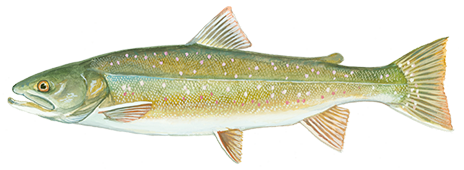Dolly Varden

The dolly varden is part of a closely related group (chars) and is difficult to distinguish from external characteristics.
HOW TO IDENTIFY A DOLLY VARDEN
Due to past misidentification of species in various locales and lack of scientific knowledge, much of the available literature on these species is either misleading or incorrect, and there is still some disagreement among scientists on their distribution.The Dolly Varden and bull trout can generally be distinguished by their size and habitat. The Dolly Varden is usually a coastal species whereas the larger bull trout is found inland in large, cold rivers and lakes draining high, mountainous areas. A greater problem arises in trying to separate Dolly Varden from Arctic char. Much of the published information on the distribution of these species is incorrect and often presupposed that only one species occurred in areas or rivers where it is now believed both species may occur. The two are outwardly almost identical in every respect and to complicate matters, significant variations occurs in both species. The spots on the Dolly Varden are usually smaller than the pupil of the eye, while on the Arctic char they are larger than the pupil. When returning from the sea both species are silvery and lack spots. Arctic char on the average have more gill rakers on the first gill arch (25-30 as opposed to 21-22 in the Dolly Varden) and more pyloric caeca (40-45 as opposed to about 30 in Dolly Varden), but fish with intermediate counts (i.e., 23 or 24 gill rakers and 35 pyloric caeca) are not at all uncommon in either species.
WHERE TO CATCH DOLLY VARDEN
The Dolly Varden is known to occur from the Sea of Japan through the Kuril Islands to Kamchatka, through the Aleutian Islands and around Alaska to the Yukon and Northwest Territories (Canada) in the north and the northwestern United States in the south. Like the Arctic char (Salvelinus alpinus), it is an anadromous fish though some populations are landlocked. The following list includes additional details on where to catch this fish:
BACKFLOW BAYS AND ESTUARIES
OUTSIDES OF BENDS RIVERS AND STREAMS
SCHOOLS DROP-OFFS
MERGING CURRENTS STANDING WAVES
CURRENT EDGES BAYS
CHANNEL ENTRANCES ROCK AND BOULDER POCKETS
RIPPLES, CURRENTS, SWIRLS AND SPRAYS DAMS AND FALLS
EDDIES SMALL POINTED WAVES
UNDERCUTS
HOW TO CATCH DOLLY VARDEN
The following are fishing methods used to catch this fish:
JIGGING FLY FISHING
STILL FISHING DRIFT FISHING
TROLLING
DOLLY VARDEN LURES, TACKLE & BAIT
The following are lures, tackle or bait that can be used to catch this fish:
CURED FISH ROE FLIES
SALTWATER LIVE BAIT SPOONS
PLUGS SPINNER BAITS